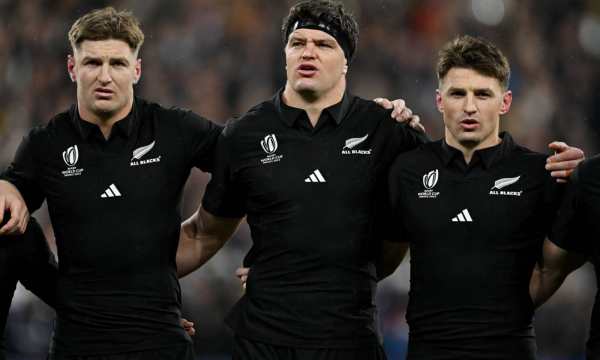All Blacks: How These Legends Shaped Rugby
The All Blacks have transformed world rugby with a dominance that transcends generations and continents.
Anúncios
Behind the iconic black jersey lies a rich history of tradition, innovation, and continuous excellence.
Have you ever wondered how a country of just 5 million people can consistently produce the most feared team in the sport?
Or why the haka sends shivers down the spine even of those who have never watched a match?
Discover what makes the All Blacks not just a team, but a true cultural phenomenon that has redefined the limits of the sport.
Discover the Origin of the All Blacks
The name “All Blacks” emerged during the historic British tour of 1905 when an impressed journalist wrote about the team playing like “all backs” (all attackers).
A printing error transformed the phrase into “All Blacks”, coinciding with their all-black uniforms. The team won 34 of the 35 games on that tour, immediately establishing their formidable reputation.
The identity of this team is deeply rooted in Maori culture, the indigenous people of New Zealand.
Values such as humility, excellence, and teamwork form the core of the “Better People Make Better All Blacks” philosophy.
Players learn from an early age that no one is greater than the black jersey.
The New Zealand team systematically “sweeps the shed” after games, demonstrating that even the biggest stars keep their feet on the ground.
This team has transformed a small country into a sporting superpower through an unparalleled development system.
Children all over New Zealand grow up dreaming of the black jersey, creating a culture where rugby is not just a sport but a fundamental part of national identity.
The Evolution of the Uniform: From All Black to Silver Fern
The All Blacks’ all-black uniform is possibly the most iconic in world sports. The choice of black dates back to 1893 when New Zealand officially adopted this color to differentiate itself from other teams.
Initially minimalist, the uniform evolved to incorporate the famous silver fern in the 1920s. The fern, native to New Zealand forests, symbolizes strength, growth, and perpetuity.
Technology has transformed the uniform over the decades without compromising its classic aesthetic.
Modern fabrics have become lighter, more breathable, and more durable, optimized to enhance athletic performance.
The partnership with Adidas, which began in 1999, revolutionized the design while maintaining the sacred tradition of the black jersey.
Each uniform is rigorously tested to withstand the extreme conditions of elite rugby.
Haka: The Warrior Dance that Intimidates Nations
The All Blacks’ haka transcends rugby, becoming one of the most recognizable rituals in world sports.
This Maori warrior dance, performed before each international match, establishes psychological dominance even before the first contact.
“Ka Mate” was the haka traditionally performed until 2005 when “Kapa O Pango” was created specifically for the team.
Each movement of the haka carries deep meanings rooted in Maori culture. The wide eyes (pukana) symbolize life, while the protruding tongue represents the challenge to the opponent.
The slapping of thighs and arms demonstrates strength and vitality, mentally preparing the players for the imminent match.
The All Blacks train the haka with as much seriousness as their tactical moves. Some opposing teams have developed iconic responses to the haka over the years.
France advanced in a V formation during the 2011 World Cup, while England formed a semicircle in 2019.
Respect for the haka has become so important that World Rugby has established specific protocols for the response of opposing teams.

Haka-Maori-dance-(Source-Google)
Top All Blacks Players of All Time
The All Blacks have produced some of the greatest talents in rugby history.
Richie McCaw, with 148 international matches and two World Cup titles as captain, set the ultimate standard of leadership and continuous excellence.
Dan Carter revolutionized the fly-half position with his tactical precision and decisive kicks in critical moments, including the 2015 World Cup final.
Jonah Lomu completely transformed the concept of the wing in modern rugby. His unique combination of size, strength, and speed terrified defenses between 1994 and 2002, permanently changing the way we perceive elite athletes.
The All Blacks also celebrate the genius of Christian Cullen, whose intuitive running lines produced 46 tries in just 58 international matches.
The modern era continues to produce legends like Beauden Barrett, twice the world’s best player, and the Barrett brothers (Beauden, Scott, and Jordie) – the first family trio to represent the team simultaneously.
Sam Whitelock set new longevity records in the second row, while Aaron Smith redefined the role of scrum-half with his impeccable distribution and exceptional game vision.
Offloads: The Team’s Trademark
The All Blacks have elevated the art of offloads to unprecedented levels in world rugby.
This ability to keep the ball alive even under defensive pressure makes their attack virtually impossible to contain.
New Zealand’s development system prioritizes ball-handling skills from youth categories.
Even the heaviest forwards demonstrate handling dexterity comparable to backs from other teams.
The technical precision of the All Blacks’ offloads results from thousands of hours practicing in deliberately challenging conditions.
Coaches often create scenarios where players must execute precise passes under extreme physical and mental pressure. The concept of “skills under pressure” defines the team’s training methodology.
This superior ability to maintain possession in nearly impossible situations allows New Zealand players to sustain attacking phases that eventually break even the most organized defenses.
Iconic Plays that Defined Modern Rugby
The New Zealand team consistently redefines the tactical boundaries of rugby, introducing revolutionary plays that inspire global imitation.
The “loop play” executed to perfection by Dan Carter and Ma’a Nonu has become a staple of all top-level teams.
The manipulation of space through angled runs and timed passes has become the signature of the New Zealand backline under innovative coaches like Wayne Smith.
The match against South Africa in 2013 produced what many consider the “perfect try” of modern rugby.
Starting from their own 22-meter line, the All Blacks strung together 11 precise passes culminating in Beauden Barrett’s spectacular try.
This sequence exemplifies the total game philosophy that dissolves traditional boundaries between forwards and backs, prioritizing continuity and constant support.
The ability to turn defense into attack in seconds has become a devastating psychological tactic against opponents.
The ability to adapt tactically during matches, often identifying and exploiting opponent weaknesses in real-time, highlights the collective intelligence that sets the All Blacks apart from other rugby powerhouses.

Beauden-Scott-and-Jordie-Barrett-(Source-Google)
Unbeatable Achievements and Records on the Field
The three Rugby World Cup titles (1987, 2011, and 2015) only scratch the surface of the historical dominance of New Zealand players.
With an impressive 19 Rugby Championship/Tri Nations titles, the team’s hegemony in the southern hemisphere has remained virtually uncontested for decades.
No professional sports team maintains a comparable win rate. With an incredible 77% of victories in over a century of international competitions, their consistency defies conventional explanations.
The New Zealand team holds the world record of 18 consecutive wins in international tests between 2015 and 2016, an extraordinary demonstration of dominance against the best teams on the planet.
The Bledisloe Cup, contested annually against Australia, remained in New Zealand’s possession for 20 consecutive years.
This regional hegemony extends beyond borders, with 11 Grand Slams won on tours of the United Kingdom and Ireland.
The team’s ability to reinvent itself after each cycle of retirements demonstrates the extraordinary depth of New Zealand’s development system.
The Greatest Rivalries that Generated Epic Matches
The rivalry between the All Blacks and the Springboks transcends the sport, representing one of the most intense and significant confrontations in world rugby.
Since their first encounter in 1921, these southern hemisphere titans have starred in epic matches laden with cultural and political symbolism.
The historical balance between these powerhouses is reflected in the consistently close results and exceptional physical intensity of the confrontations.
The duels against Australia for the rights to the Bledisloe Cup represent another fundamental rivalry.
New Zealand’s recent dominance in this confrontation only increases Australia’s determination in each new clash. Matches against England carry the special symbolism of facing the sport’s inventors.
The English represent the northern hemisphere’s challenge to southern rugby traditions, often with contrasting playing styles.
The confrontation with France adds unique elements of unpredictability that fascinate fans.
France’s ability to rise against the New Zealand team has become legendary, producing some of the greatest upsets in international rugby history.
Each major rival helps shape the competitive identity of the All Blacks through specific challenges.
Little-Known Facts About the All Blacks
The All Blacks follow strict internal traditions that rarely reach public knowledge.
Since 1986, new members must share significant personal stories during the first dinners with the group, establishing vulnerability and authentic connection.
The “Sweeper Rule” requires veterans to clean the locker room after each match, eliminating any sense of stardom even among superstars.
The secret ritual of presenting the first jersey remains virtually unknown to the public.
A veteran player presents the uniform to the debutant the night before their first match, sharing stories about the historical significance of the garment.
Each player receives a unique sequential number that identifies their position in the team’s historical lineage, regardless of their position on the field.
The All Blacks’ scientific department develops proprietary technologies rarely disclosed. Advanced biometric monitoring systems completely personalize training and recovery regimes.
Players participate in regular mental training programs with techniques derived from elite military and astronaut practices. Even nutrition follows individualized protocols based on specific genetic profiles.
Final Considerations
The unique combination of deeply respected tradition and constant innovation has established a model that teams in all sports try to replicate.
The All Blacks’ legacy demonstrates how fundamental values such as humility, collective dedication, and relentless pursuit of continuous improvement can produce extraordinary results.
As rugby continues its global expansion, the All Blacks remain its principal ambassador and ultimate reference of excellence.
For true sports enthusiasts, understanding the team means understanding the essence of rugby in its purest and highest form.
The legend continues to be written with each new generation that wears the black with the silver fern.
FAQ
How do the All Blacks maintain their excellence after the retirement of great stars?
Do the All Blacks really sweep the locker room after games?
What was the All Blacks’ longest unbeaten streak?
How are the All Blacks’ captains chosen?
How many World Cup titles have the All Blacks won?
 7 Bigger Rugby Fields Every Fan Should Know
7 Bigger Rugby Fields Every Fan Should Know
Pure adrenaline, tradition and unforgettable victories: that’s what great rugby fields are all about. Anúncios Have you ever stopped to think about the rugby fields that […]
Keep reading World Rugby Sevens: Get to Know Everything About the Olympic Tournament
World Rugby Sevens: Get to Know Everything About the Olympic Tournament
Discover the electrifying energy of World Rugby Sevens and get ready to fall in love with this dynamic sport. Anúncios This championship combines speed, skill and […]
Keep reading How to Watch Live Rugby on DAZN: Your Complete Guide
How to Watch Live Rugby on DAZN: Your Complete Guide
Ready to feel the excitement of live rugby without leaving your couch? Experience the adrenaline with the Dazn App! Anúncios If you’re someone who cheers for […]
Keep reading